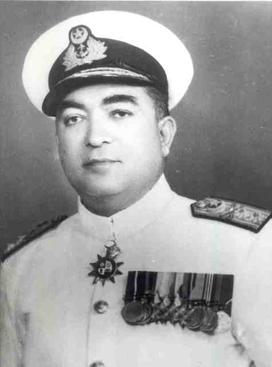
The Pakistan Navy (PN) is the naval warfare branch of the Pakistan Armed Forces. The Chief of the Naval Staff, a four-star admiral, commands the navy and is a member of the Joint Chiefs of Staff Committee. The Pakistan Navy operates on the coastline of Pakistan in the Arabian Sea and Gulf of Oman. It was established in August 1947, following the creation of Pakistan.

PNS Tariq (DDG-181) was the lead ship of the Tariq-class destroyers in the Surface Command of the Pakistan Navy that served in the military service from 1993 until 2023. Prior to being commissioned in the Pakistan Navy, she served in the Royal Navy, as general purpose frigate HMS Ambuscade.

PNS/M Ghazi (S–130), SJ, was a Tench-class diesel-electric submarine, the first fast-attack submarine in the Pakistan Navy. She was leased from the United States Navy in 1963.

The Tariq-class destroyers were a class of guided missile destroyers of the Pakistan Navy. They were acquired from the British Royal Navy in 1993–94. The Tariqs were formerly commissioned in the Royal Navy's Surface Fleet as Type 21 (Amazon-class) frigates, a general purpose frigate in the Royal Navy.

The Pakistan Navy Special Service Group is the special operations force tasked with the conducting the small-unit based military operations in all environmental formats of the sea, air, and land by adopting to the tactics of the unconventional warfare.

The Pakistan Marines or simply as Pak Marines, is an expeditionary and amphibious warfare uniform service branch within the Pakistan Navy, consisting of the naval officers and other personnel to perform their duties within the Marines. Pakistan Marines are responsible for providing force protection in littorals, using the mobility of the Pakistan Navy to provide creeks defence, ground based air defence and Force protection.

Afzal Akram Rahman Khan, HQA, HPk, HJ, was a Pakistan Navy admiral, politician, and the Commander in Chief of the Pakistan Navy, serving under President Ayub Khan from 1959 until 1966. He is noted for being the longest serving commander-in-chief of navy and was responsible for launching and introducing the submarine program in the navy.

PNS Munsif (M166) is the lead ship of the Munsif-class minehunter currently in service with the Pakistan Navy.
PNS/M Khalid (S-137) is a diesel-electric fast-attack submarine equipped with an air–independent propulsion system and the lead ship of her class active since her commissioning in the Navy in 1999.
Military exercises are conducted by the Pakistan Armed Forces to increase combat readiness, and to identify problems in logistics, training, and current military doctrine. They also test the ability of units to work together. Lastly, they act as a visible expression of military might, which acts as a deterrent to potential enemy action. An important component of each exercise is the after-action assessment. Since 1989 the four branches services have increasingly begun coordinated exercises.

The Pakistan Navy Station Iqbal is a naval base located off the Karachi coast, Sindh, Pakistan. The PNS Iqbal serves as the command post of the Pakistan Navy Special Service Group that were commissioned in 1966.
The PNS Zafar, or Naval Base Zafar is a naval base located in the vicinity of the Navy NHQ in Islamabad, Pakistan. Commissioned in 1974, it serves as a headquarter of the Northern Command of the Pakistan Navy.
PNS Akram is a naval base located in Gwadar, Balochistan, Pakistan. Established in 1983 and commissioned as PNS Akram in 1987, it serves as the forward operating base for the Pakistan Navy and acts as a military depot for all naval personnel stationed as part of the Western Command. It is namesake in the honor and in memory of Admiral Afzal Rahman Khan, and is the first naval base to be established on the Makran Coast of Balochistan.

PNS Babur (D-182) was a Tariq-class destroyer that served in the Surface Command of the Pakistan Navy from 1993 until being decommissioned in 2014. Before commissioning in the Pakistan Navy, she served in the Royal Navy, formerly designated as HMS Amazon as a general purpose frigate.

PNS Badr (D-184) was the Tariq-class destroyer that served in the Surface Command of the Pakistan Navy from 1994 until being decommissioned from the service in 2014.

PNS Tippu Sultan (DDG-185), a Tariq-class destroyer, served in the Pakistan Navy after it was acquired in 1994. Her design was based on the British Type 21 frigate, and previously served in the Royal Navy as HMS Avenger as a general purpose frigate.

PNS Shah Jahan (DDG-186) was a Tariq-class destroyer in service with the Pakistan Navy since being recommissioned in 1994. Based on the British design, Type 21 frigate, she previously served in the Royal Navy as HMS Active as a general purpose frigate.
Abdul Waheed Bhombal, SI(M), best known as A. W. Bhombal was a two-star rank admiral in the Pakistan Navy and the chairman of the Pakistan National Shipping Corporation from 1980 until retirement from military service in 1986. Bhombal was disciplined by the Pakistani Navy for his role in the friendly fire sinking of PNS Zulfiqar after the missile attack on the Port of Karachi.
The 25th Destroyer Squadron (DESRON-25) is one of the two destroyer squadrons in the Pakistan Navy and is part of the six total squadrons in the fleet. It is the largest squadron in the navy, second only to the 9th Auxiliary Squadron in terms of ship count and the largest squadron by role. It comprises a fleet of various destroyers, including Tariq-class destroyers, Yarmook-class corvettes, Tughri, and Zulfiquar-class frigates. The Squadron previously operated a fleet six Tariq-class destroyers tasked with various roles, including anti-aircraft, anti-submarine, and anti-surface warfare. The squadron is responsible to the Fleet Command, operating under the commander, Pakistan Fleet.













